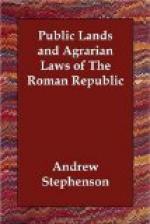Lines 8-10 declare that the censors shall, from time to time, enter this land upon their books like any other private property; and it is further declared that nothing shall be said or done in the senate to disturb the peaceful enjoyment of this land by those persons possessing it.
Of lines 11-13 (ch. II) nothing definite can be said, because of the few words which have been preserved.[27] Rudorff explains them as referring to land granted to viasii vicani (dwellers in villages along the roads), by the Sempronian commissioners; such lands to remain in their possession, but to be theoretically ager publicus.
Lines 13-14 refer to lands occupied since 133 agri colendi causa. They allow to every Roman citizen the privilege of occupying, for the purpose of cultivation, thirty jugera of public land; they further declare that he who shall possess or have not more than thirty jugera of such land, shall possess and have it as private property,[28] with the provision that land so occupied shall be no part of the public land excepted from appropriation, and further, that such occupation shall not interfere with the guaranteed lands of a previous possessor.
Lines 14-15 relate to holders of pasture land (ager compascuus). This ager compascuus was land which had been left undivided, and had not become the private property of any individual, but was the common property of the owners of the adjacent lands. These persons had the right to pasture stock upon this land by paying pasture dues (scriptura or vectigal) to the state. The Thoria lex freed these lands from the vectigal or scriptura, and granted free pasturage to each man for ten head of large beasts—cattle, asses, and horses—and fifty head of smaller animals—sheep, goats, and swine. This common pasture must be carefully distinguished from the communal property which was granted to the settlers in a Colonia and called “compascua publica” with the additional title[29] of the colony, as “Julienses.”
These rights of common resemble, in some respects, the English common of pasture as described by Bracton.[30] By English customary law, every freeholder holding land within a manor, had the right of common of pasturage on the lord’s wastes as an incident to his land.
Lines 15-16. The possession of land, granted by the commissioners in a colony since 133, to be confirmed before the Ides of March next.
Lines 16-17. The same rule applied to lands granted otherwise by the same commissioners.
Line 18. Such occupants if forcibly ejected to be restored.
Lines 19-20. Land assigned by the Sempronian commission, in compensation for land in a colony which had been made public, to become private.
Lines 23-24. Confirmation of the title or restitution of such land to be made before the Ides of March next.




